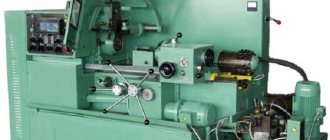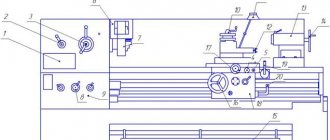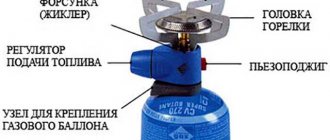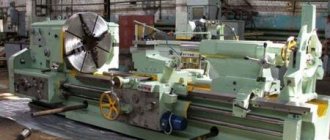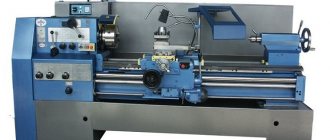A popular type of connection of individual pipeline elements is the threaded type. It provides sufficient tightness for working with gases, liquids, and aggressive acids. To create correct threads on an industrial scale, it is not enough to use hand tools. A pipe cutting machine is used for this.
Working with a pipe cutting machine
Operating principle and design
To understand how a pipe threading machine works, you need to understand its design. It consists of several interconnected elements:
- Spindle with chucks for securing pipes.
- Electric motor for transmitting rotational force.
- The bed on which the remaining parts are fixed.
- Guides for moving the spindle.
- A lunette used to process metal products.
Modern enterprises install CNC equipment. It allows you to carry out work more accurately, without human effort. This improves productivity. However, operators with practical experience in setting up such software control should work with such machines.
The principle of operation is that a pipe is fixed in the cartridge. Then the master starts the machine. Processing of the product begins using equipment fixed in the steady rest. In this case, only the pipe rotates.
Thread control
The thread pitch is measured with a thread template, which is plate 2 (Fig. 4.46), on which teeth are applied with a thread pitch indicated on the template plane. A set of templates for metric or inch threads is fastened into cassette 1. Thread templates are used to determine only the thread pitch.
The correctness of the internal and external threads made on a part is comprehensively assessed using thread gauges (Fig. 4.47). Thread gauges are divided into go-through gauges, which have a full thread profile and are, as it were, a prototype of a threaded connection part, and non-go-through gauges, which control only the average diameter of the thread and have a shortened profile.
To measure the outer, middle, inner diameters and thread pitch, thread micrometers are used (Fig. 4.48). A thread micrometer has mounting holes in the spindle and heel into which sets of replaceable inserts are installed that correspond to the thread elements being measured. For ease of measurement, a threaded micrometer is fixed in a stand and then adjusted according to a template or standard.
Before testing, the parts being tested must be cleaned of chips and dirt. During the inspection process, you should handle the gauges carefully so that nicks and scratches do not appear on their working threaded surface.
Main characteristics
The operation of a pipe threading machine is influenced by a number of parameters:
- Power indicator. If the equipment is used for mass production, this parameter can reach 2.2 kW. For individual work, installations with a power of about 750-800 W are suitable.
- Spindle rotation speed per minute. The maximum value is up to 520 rpm. On expensive models, a regulator is installed, with which you can select the speed of the machine.
- Dimensions, installation weight.
- Automation type.
- Acceptable dimensions of workpieces for processing.
Some models have additional functions that are indicated by the manufacturer in the technical data sheet.
The main advantages of the presented equipment
- Versatility.
Many pipe threading machines are suitable for stationary and mobile use. The presented equipment is used both for long-term operation on a construction site or in a workshop, and for mass production. - High security and ease of use.
Even a beginner can clamp the pipe and process it. If safety rules are followed, the pipe will not be damaged. The operator will not be injured either. All the main elements that ensure pipe processing are carefully hidden. - The presence of a centering clamp to hold the pipe.
Thanks to it, the pipe is axially aligned. This reduces the risk of defects during the thread cutting process. By tightly clamping the pipe, a special cartridge prevents any displacement from the axis. - Long service life.
You can use the pipe cutting equipment for a long time even under constant load. With each cutting, the resource of only the main elements is reduced. They can be replaced. - High quality of finished products.
Pipe cutting work is carried out carefully and in accordance with the specified parameters. You get the pipes (plastic or metal) that you need (with the right type of thread). - Availability.
Pipe processing will be as economical as possible. Choose! Our specialists will assist you in choosing a tool for pipe processing. We guarantee prompt deliveries. Any equipment for cutting threads on pipes (external and internal threads) can be delivered to you in the shortest possible time. We do not inflate prices for products. Contact us! Selecting the necessary equipment to create carvings is not difficult.
Types of threading machines
Pipe cutting machines are divided according to several factors. If we talk about the degree of automation, there are 3 groups of equipment:
- Manual models. Compact designs. With such installations it is possible to process pipes up to 50 cm in diameter.
- Electric models. Industrial units, large-sized, with a large mass. Used for mass production. There are compact models that are used in private workshops.
- Automatic installations. Difficult to manage due to automation of the workflow. The operator must be able to configure the program. Suitable for processing large quantities of pipes in large plants.
There is another division based on the design of the technological operation performed. We need to talk about this in more detail.
Automatic pipe cutting machine
Thread rolling
Pipe cutting machines of this type operate on the principle of changing the shape of workpieces without removing metal shavings. The part is placed on the working surface and fed to the working parts, which can be semicircular or flat. The pipes are compressed. Pressure creates a thread.
To perform the task, special equipment is used: dies, rollers of various shapes.
Thread milling
When using pipe cutters in this category, comb and disk cutters are used. After starting the engine, the pipe begins to rotate slowly. A milling cutter is fed along it, with which the thread is cut. On such machines it is possible to create extended connections with large pitches. Comb cutters are used to cut threads with fine pitches along the entire length.
Thread grinding
Grinding pipe cutting machines are used for processing hobs, knurling rollers, and lead screws. For this, single-thread and multi-thread abrasives are used. The equipment with abrasive rotates, and the pipe is fed longitudinally.
Thread cutting with cutters
A widespread element of machine parts is external and internal threads. In mechanical engineering, fastening threads with a triangular profile, running threads with a rectangular and trapezoidal profile, and conical threads are used. Thread cutting is carried out with cutters (fixed and rotating), combs, dies, thread-cutting heads, thread cutters and taps, thread finishing is done with grinding wheels. The production of threads using the method of plastic deformation - rolling with dies and rollers - is widely used.
Thread cutting with cutters
Thread cutting with cutters is carried out on screw-cutting lathes. The part installed in the chuck or centers rotates, and the cutter, fixed in the tool holder, moves along the generatrix of the thread, and these movements are strictly coordinated: for one revolution of the part, the cutter moves by the amount of the thread pitch. The movement of the caliper when cutting threads is transmitted from the lead screw, which is connected to the spindle through a gearbox (the gear ratio is equal to the ratio of the pitch of the thread being cut to the pitch of the lead screw).
Flat, tangential and disc single-profile or multi-profile (comb) cutters are used (Figure 1). The profile of the cutter corresponds to the profile of the thread root. To prevent distortion of the thread profile, they are usually sharpened with a rake angle of zero and installed so that the leading edge is at the height of the centers. The cutter is fed in two ways: perpendicular to the axis of the part (Figure 2 a), with the cutter working with the entire profile, and parallel to the generatrix of the thread (Figure 2b); in this case, the cutter works with one cutting edge.
When cutting threads with large pitches, pre-processing is carried out with a slotted cutter with a profile angle that differs from the thread profile angle by 5-10?. Lathes are used to cut threads on long parts or in cases where the thread must be strictly concentric with other surfaces processed in the same installation. Labor productivity is low, since cutting is carried out in five to ten or more passes, a lot of time is spent on the reverse stroke and setting the cutter to size. In addition, this work is performed by highly skilled workers and requires intense attention, especially when cutting internal threads. On precision machines it is possible to cut threads of the first accuracy class. On lathes and thread-cutting machines, threads are cut with rotating cutters - vortex or enveloping cutting. To do this, a device with a head driven by an electric motor is installed on the machine support. The head is installed at an angle equal to the helix angle of the thread. The head contains cutters for cutting threads (Figure 3). The part is fixed in centers or a chuck. The rotation speed of the part is less than the rotation speed of the cutter. The head rotates at a speed that provides a cutting speed of 100-300 m/min, and moves together with the support by the thread pitch per revolution of the part. Thread cutting is done in one pass. Whirlwind cutting is used for processing threads no higher than the second accuracy class and for preliminary cutting of large threads on long parts.
The material of the article is written on the basis of the literary source “Production Technology of Internal Combustion Engines” M. L. Yagudin
Selection principles
To choose a pipe cutting machine that will meet all your wishes, you need to pay attention to a number of factors:
- Strength of the bed.
- Automation type.
- Machine power.
- The maximum permissible diameter for processing products.
- Distance between working parts.
- The diameter of the hole located in the spindle.
- Availability of protective shields in the work area.
We must not forget about the weight and dimensions of the installation.
Among the most popular models on the Russian market are:
- TURBO-400 2V. Price - 70,000 rubles. Used for serial processing of metal products.
- ROPAUER R 50. Price - 180,000 rubles. Advantages: high performance, reliability, accuracy.
- TURBO-500. Price - 130,000 rubles. Similar to previous models in terms of performance. Used for multi-batch production.
- Tornado REMS. Price - 150,000 rubles. Used for cutting pipes, rolling grooves, removing grants.
- ROBOT-2. Price - 400,000 rubles. Used for cutting nipples, threads, and removing grants. Suitable for small workshops, construction sites.
CNC models are much more expensive.
Small pipe cutting machine
Application of pipe cutting machines
Depending on the model, pipe cutting machines are used for cutting copper, cast iron, steel pipes, pipelines made of alloys and plastic.
| Equipment | Types of pipes |
| Fireless cutting machines | Pipes of increased flammability, for example, made of polymers. |
| Machines – roller pipe cutters | Pipes made of copper, brass |
| Gas cutting machines | Steel pipes, pipes made of cast iron, ferrous metals |
| Guillotines | Composite and multi-component pipes |
| Grinding machines | Composite and multi-component pipes |
| Orbital pipe cutters | Plastic, steel, iron, cast iron pipes |
| Pipe band saws | Pipes made of cast iron, copper, non-ferrous metals and alloys, cast iron, steel, iron |
If you have any questions about the equipment, contact our specialist in one of the following ways:
- By phone 8-800-555-95-28 (toll-free within Russia);
- By sending an application by email;
- By filling out the application at the bottom of the page.
Exploitation
Pipe threading machines are precision equipment that requires compliance with operating rules:
- Check in advance the accuracy of the alignment of the product relative to the working parts.
- Depending on the type of equipment, choose equipment for thread cutting.
- Check the integrity of the cutters and abrasives before turning on the engine. If there are chips, burrs, or visual damage, replace the equipment.
- When carrying out work, wear protective clothing and goggles.
- Do not attempt to process pipes with a diameter exceeding the permissible value.
- Learn how to set up CNC installations before starting to process products.
If the part was clamped unevenly in the chuck, the threads will be cut at an angle. This will lead to product defects and equipment failure.
Pipe cutting machines are used to create strong connections between individual parts of pipelines. They allow you to speed up the technological process and carry out processing more accurately.
